
International Journal of Scientific & Engineering Research, Volume 3, Issue 5, May-2012 1
ISSN 2229-5518
The Backmixing-Diffusion Concept for Mass Transport Phenomena of Pineapple Juice Extraction Using a Reversing Continuous Countercurrent Extractor
Chairat Siripatana, Waigoon Rittirut, Thummarat Thummadetsak
between experimental data and the predictions for concentration profiles were due to the variations in Biot number and Peclet number along the length of extraction unit. Nevertheless, the simulation was successful for pineapple juice extraction process.
Index Terms— backmixing, countercurrent extraction, pineapple juice, reversing continuous countercurrent extractor, RCCE, solid-liquid diffusion
—————————— ——————————
A study on mass transfer in a pineapple juice extractor was carried out. The extraction of pineapple juice from its peel was chosen as a case study using a reversing countercurrent ex- traction system (RCCE) based on Casimir [1]. A diffusion- backmixing model was used to describe the kinetics of mass transfer in the extraction unit. In estimating equilibrium dis- tribution coefficient, solute diffusivity and time delayed due to plasmolysis, collection data from batch extraction experiments were used [2]. The first two parameters were introduced to predict concentration profiles of solute in both solid and liquid phases in the extractor using diffusion-backmixing model.
According to experimental work, various extraction trials were performed by varying three variables, namely : 1) draft,
2) retention time, and 3) extraction temperature. In the expe- rimental range where temperature of 55-70 ºC, draft of 1-2 and retention time of 50-90 min, it was observed that highest yield (70.9 %) was associated with highest draft and longest retention time. Furthermore, in all trials, after system reached a steady state condition, the solute concentration profiles along the extractor were of the same pattern. The diffusion- backmixing model was used to predict the concentration pro- files satisfactorily. In general, the predictions agreed well with the experimental data in solid phase and can also approximate a closed trend in liquid phase.
Finally, the extraction system was analyzed critically. It was found that backmixing caused the reduction in driving force and the increasing in mass transfer of solute at solid-liquid interphases by convection. The combined effect of finite Biot
number ( Bi ) and Peclect number ( R ) limited the maximum
yield to about 70 % unless the design is modified. Further- more, it can be concluded that the differences between expe- rimental data and the predictions were due to the variations in
Bi and R along the extractor which had been assumed con-
stant for the model.
Thailand is one of the biggest exporter of pineapple products. Although juice concentrate is not the main product of pineap- ple processing, the country earns over 100 million dollars each year since 2004 while the consumption need and export value got increasing annually [3]. Nevertheless, in order to be com- petitive it is necessary to improve the efficiency of the whole process by reducing energy costs and minimizing the envi- ronmental problems like reduction of the effluent load.
The juice is largely produced by mechanical expression. This method yield 50-60 % of the extractable solutes as com- pared to a yield of around 80-90 % obtained by diffusion ex- traction. However, very few big processing plants have adopted for the diffusion based process, thus the potential for juice concentrate production from pineapple wastes is still highly unexplored. In this study, a pilot-plant scale extractor described initially by Casimir [1] and subsequently used by others [4], [5] was considered to produce the juice from peels. The extractor details are given accordingly. The extractor illu- stration (Fig. 1) was also shown in the previous work [6], [7].
IJSER © 2012
The research paper published by IJSER journal is about The Backmixing-Diffusion Concept for Mass Transport Phenomena of Pineapple Juice Extraction Using a Reversing Continuous Countercurrent Extractor 2
ISSN 2229-5518
Siripatana [6] studied juice extraction processes from ap- ples and pears using this extractor. More than five diffusion models were tested for describing mass transfer. It was found that the so-called ―diffusion-backmixing model‖ gave the best prediction. Gunasekeran et al. [5] represented backmixing in a continuous diffusion processes by a series of well-mixed tanks. According to their experimental data and the predic- tions of their model, the extractor showed very low level in backmixing i.e. high Peclet numbers. This was not consistent with the earlier work of Siripatana [6].
The solid and liquid phase in normal operation can vary great- ly along the trough. The reason is due to inclination of the trough inside the extractor (slope) and the movement of solid and liquid phase relative to the screw conveyor. Nevertheless, the volumetric flow rate of both phases along the trough may be assumed constant at steady state conditions. For this rea- son, the model described here will be based on the volumetric flow rates of solid and liquid phases instead of their linear velocities. With this modification, the solid and liquid phase material balances will be equal to that conventional ones de- veloped by Mecklenburgh and Hartland [10]. In this work, the solution can thus be rewritten to provide equivalent results as given by traditional backmixing [10] where average velocity is treated as constant.
Considering material balances around CCDE as shown in
1) The volumetric flow rate for both solid and liquid phases are constant.
2) The volumetric overall mass transfer coefficient ( K x ), draft of extraction ( ), and the equilibrium distribution coefficient ( m ) are constant along the trough.
3) The volumetric dispersion coefficient ( Dx and D y for
solid and liquid phases, respectively) are constant and independent of the position along the trough.
Among comprehensive model based on diffusion and liquid
L, yout
y
phase backmixing theory was given by Lee and Schwartzberg
LyDy
1dvy
LyDy
L, yin
[8]. The set of solution with any extent of backmixing was giv- en. The solution is rather complex, yet it is not obvious how
y v
dvx
y y
the solution can be made to reconcile for the asymptotic case
SxD x
d
x
x 1v
SxD
(plug flow) with the well known solution given by Spanink
S , x
vx
xv
xv
S , x
[9].
in
Vx 0
x x
V
x
out

In addition, the earlier workers have ignored the time re-
z 0
z 1
quired for plasmolysis. The objectives of this investigation
thus were to :- 1) explore the potential of continuous counter-
current diffusion extractor (CCDE), like RCCE unit, for the
extraction of pineapple juice; 2) develop a mathematical model which can explain mass transport in necessity of fundamental parameters like in-solid diffusivity, draft of extraction (corres-
————————————————
Chairat Siripatana is at School of Engineering and Resouces, Walailak
University, Thailand . E-mail: schairat@wu.ac.th
Waigoon Riitirut is at School of Agricultural Technology, Walailak Uni-
versity, Thailand . E-mail: rwaigoon@wu.ac.th
Thummarat Thummadetsak is currently working for Petroleum Authority
of Thailand Companny, Limited, Thailand E-mail: thumma-
rat.t@pttplc.com
ponding to liquid to solid feed ratio) and time delayed due to plasmolysis (extraction time corrected for cell plasmolysis).
Fig. 2. Schematic view of material balance for differential volume, dvx , along the trough of extraction unit.
Under the above assumptions, material balance around control volume dV is as follow:-
For solid phase:
(solute flow rate at inlet)- (solute flow rate at outlet)- (rate of solute transferred to liquid phase) = (rate of solute accumu- lated in the volume)
IJSER © 2012
The research paper published by IJSER journal is about The Backmixing-Diffusion Concept for Mass Transport Phenomena of Pineapple Juice Extraction Using a Reversing Continuous Countercurrent Extractor 3
S x
x x K
dA x x* x
vx
vx S
vx
s dvx t
(1)
At steady state condition, the above equation is thus re-
Tx x Kx / S t f Kx
, t f t tl t p
duced to:-
Here, t f is theoretical extraction time as described by equ-
ation (4). The equation was given in Siripatana’s work (Siri-
patana, 1986) and then claimed by Thummadetsak (1996).
dx
Dx
d 2 x
y
S dv
![]()
2 2 K x x m 0
(2)
t f t tl t p
(4)
x Sx dz
Where,
Where
t is the actual extraction time.
![]()
z vx x
; x* y / m ; and
tl is time lead due to initial solute distribution in solid. The parameter is introduced to correct for the time taken
![]()
K dA K x
dvx
![]()
He
K x is volumetric overall mass transfer coefficient (s-1)
S is volumetric flow rate of solid phase (m3/s)
S0 is volumetric flow rate of solid phase at inlet of extrac-
tion unit (m3/s)
S f is volumetric flow rate of solid phase at outlet of ex-
traction unit (m3/s)
L is volumetric flow rate of liquid phase (m3/s)
for the Sherwood number to allocate an asymptotic value, and
t p is time delayed due to plasmolysis.
![]()
It was noted that the concentration in solid phase ( x ) in equation (3) is sometimes normally expressed as the average concentration ( x ) as shown in some works [6], [11].
(ii) For liquid phase:
Considering material balance of solute in liquid phase at inlet
L0 is volumetric flow rate of liquid phase at inlet of extrac- tion unit (m3/s)
and outlet of differential volume, is given
dvy , the following equation
L f is volumetric flow rate of liquid phase at outlet of ex-
traction unit(m3/s)
y
Dy
y dA y
x is solute concentration in solid phase (kg/m3)![]()
L
![]()
![]()
Ks
![]()
![]()
x x*
y is solute concentration in liquid phase (kg/m3)
v y
v y
L v y
dv y t
(5)
vx is accumulated volume of solid phase from its inlet point to position considered (m3)
Similarly, at steady state condition, the above equation can
v y is accumulated volume of liquid phase from its inlet
point to position considered (m3)
x is total volume of solid phase in extraction unit
y is total volume of liquid phase in extraction unit
be rewritten in ordinary differential equations (ODEs) and
then converted to dimensionless form,
1 d 2 y dy
Dx is volumetric dispersion coefficient in solid phase
(m6/s)
R dz
![]()
![]()
![]()
2 dz TL x y m
(6)
Dy
(m6/s)
K S
is volumetric dispersion coefficient in liquid phase
is overall mass transfer coefficient (m/s), a parameter
where![]()
Ks dA
depending on solute diffusivity from diffusion theory![]()
vy vx , L S ,
y mx* ,
![]()
K x dv , z vx x
dA is area of mass transfer in volume dvx
(m2)
x* is solute concentration in solid phase at equilibrium
condition (kg/m3)
y* is solute concentration in liquid phase at equilibrium condition (kg/m3)
Here, subscript x is denoted for solid while subscript y is for liquid.
Converting equation (2) to dimensionless form,
1 d 2 x dx
![]()
R y L ![]() Dy =Peclet number in liquid phase= Ty y
Dy =Peclet number in liquid phase= Ty y ![]() L K x Tx S L
L K x Tx S L
Equation (1)–(6) are actually similar to what were shown in the previous work at steady state condition [12].
Considering characteristics flow of solid and liquid phase around the inlet and outlet of extraction unit in cooperation with the fact that there is no concentration change of x and
y left out of extractor. The usual boundary conditions of eq-
uation (3) and (6) are as follow:-
P dz
![]()
![]()
![]()
2 dz Tx x y m
(3)
Where![]()
P x S Dx
=Peclet number in solid phase,
IJSER © 2012
The research paper published by IJSER journal is about The Backmixing-Diffusion Concept for Mass Transport Phenomena of Pineapple Juice Extraction Using a Reversing Continuous Countercurrent Extractor 4
ISSN 2229-5518
x x 1 dx at
z 0
(7)
b) The trough was inclined at 4 degree to the horizontal.![]()
in P dz
c) The solid feed rate was maintained at 12 kg/h by dropping 2 kg of raw material manually at 5-min.
y y,
1 dy 0 at
z0
(8)
intervals. Before each run, the feed was preheated to![]()
out R dz
about 70 ºC for more than 5 min. to plasmolyze the
y y 1 dy at
z 1
(9)
cell structure so that time of cell plasmolysis ( t p ) was![]()
in R dz
essentially zero.
d) The average operating temperatures were controlled
x x,
1 dx 0 at
z 1
(10)
at 55, 62.5 and 70 ºC for different runs.![]()
out P dz
Where
e) Retention times of solid were set as 50, 70 and 90 min. f) The following ratios of liquid to solid flow rate were![]()
investigated:- 1:1, 1.5:1 and 2.0:1. Drafts ( Lm S )
xin and
yin
is the solute concentration in solid and liquid
were calculated by averaging the liquid to solid ratio
phase at inlet of the extractor, respectively.
at entering and leaving ends.
g) The equilibrium distribution constant was found to be
xout
and
yout
is the solute concentration in solid and liq-
1.14 for all experiments.
uid phase at outlet of the extractor, respectively.![]()
The solid phase concentration ( x ) in equation (6) and the boundary conditions is normally expressed as the average concentration ( x ) as also mentioned in earlier works [6], [10],
[11].
The solution of the above ODEs are also discussed by Meck-
lenburgh and Hartland [10] for the case where solid phase
mixing is negligible. The solution is given as follow:![]()
![]()
![]()
For QL S 1 , let J 1 Q m , m is distribution coefficient.
At steady state condition, both samples for solid and liquid phase were taken at different point along the length of extractor. The relative length ( z ) for sampling position along extraction chamber was that:- 0, 0.1, 0.3, 0.5, 0.7, 0.9 and 1.0. Soluble solids (ºBrix) in solid and liquid phase were analyzed by refractive index using Abbe refractometer.
![]()
x0 x
x0 y0
![]()
(1 w1 ) H1 / q1(1 w1 ) H 2 / q2
m (1 FW1 ) H1 / q1(1 FW2 ) H 2 / q2
(11)
Batch extraction was carried out, the extraction curves and solid dimensions were used to calculate the diffusivities [2]. The time delayed due to plasmolysis was calculated by the
y y0
( w1
H1W1 ) / q1
( w1
H 2W2 ) / q2
method described in Siripatana [6] and then claimed in some![]()
mx0 y0
![]()
(1 FW1 ) H1 / q1(1 FW2 ) H 2 / q2
(12)
work [13], [14].
Where q1 and q2 are roots of equations,
The overall mass transfer coefficient described here is actually
q2 qTx R Tx R1 /
―volumetric overall mass transfer coefficient, K x
‖ and is![]()
H 1q R,
weqz ,
W eq
defined by the following basic equation.![]()
![]()
![]()
dx K x x y ![]() m
m
(13)
The configuration of the extractor is similar to what was men- tioned in the previous work [1], [2], [6]. The relevant dimen- sions of the extractor are summarized as follow:- 2.2 m of overall length, 2.0 m of total screw length, 12 number of flights, 0.21 m of screw diameter, 21.8 m of trough width, and
30 m of trough depth. In this investigation, the operating con- ditions were in the following ranges.
a) The forward and reverse rotational speeds of the screw were identical in all trials. Nevertheless, in each cycle, the screw moved in forward and reverse direction for 25 and 22 seconds, respectively, giving the percentage progression to 6.38.
Here K x for different runs were evaluated directly from the actual concentration profiles. That is, firstly, the profiles were fitted to the fifth order polynomial with constant para- meters. Then the average K x s were determined by comparing with the solution of equation (13) such that the sum of square of error were minimized.
The liquid phase Peclet numbers ( R ) were determined by
treating it as parameters of the backmixing model (eqn. 1-12)
which must be found by fitting experimental data to the mod-
el.
The raw material used in this work was the pineapple peels
IJSER © 2012
The research paper published by IJSER journal is about The Backmixing-Diffusion Concept for Mass Transport Phenomena of Pineapple Juice Extraction Using a Reversing Continuous Countercurrent Extractor 5
ISSN 2229-5518
which were regarded as slabs for the purpose of modeling. Since the external surface (skin) of the pineapple fruits is much less permeable to solute than the inner part, the diffusion trough the skin was neglected. The mean rectangular dimen- sions were 5.22×14.9×52.0 mm3.
Biot number ( Bi Ks a / D )
Following the approach developed by Siripatana [15] with
some modifications for rectangular block, the following ap-
proximate relations can be obtained;
which is mainly sucrose, were one order of the magnitude higher than that of sucrose in aqueous solution (0.62×10-9 m2s-1 at 70 ºC). This indicates that although the asymptotic extrac- tion curves follow exponential pattern as predicted by diffu- sion theory, the main mechanism of solute transfer was not by molecular diffusion. Presumably, thermal contraction stress of the fiber matrix enhances solute transfer. This requires further investigation. Nevertheless, here it is sufficiency to claim that the observed value of diffusivities is 10 times higher than the molecular diffusion. This results agree with that given for pi- neapple slices by Beristain [16] and Sodchit [17].
1/ k
1
Bi
1
![]()
p / 1
Sh2 K x 1 1 1 Sh
In the investigated temperature range, time of plasmolysis
![]()
![]()
![]()
D 2 2 2
![]()
g ,
g ,Bi
,
l1 l2
l3
2h ,
( t p ) approached zero exponentially as temperature increased
from 50 to 70 ºC. The similar trends were found by Siripatana
h , 2.460 0.4321 ( 0.528 0.5435 ) / ( 0.03909 0.08694 ) / 2
[6] for diffusion of solute from pears and pineapples, and Sod- chit [17] for solute infusion into pineapple slices.
p 2.1426 0.9314 / 0.1575 0.9876 / ,
Where
Bi is Biot number of mass transfer.
k 0.9781 0.01467
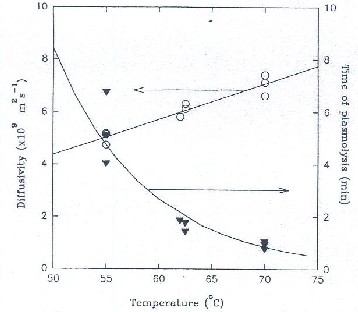
(14)
K s is mass transfer coefficient (m/s)
K x is volumetric overall mass transfer coefficient (1/s)
a is characteristic length (m)
is shape factor ( ) - 1
D is diffusivities (m2/s)
Sh is Sherwood number.
is draft.
l1 , l2 ,
and
l3 is characteristic length (half length) of each
dimension of rectangular block, as defined in Siripatana work
[15].
Following the approach used by Siripatana [6], the following approximate relation can be derived;![]()
t ln C3
q2Ds 1 1 1 2
![]()
![]()
![]()
f 1 1
l 2 l 2
l 2 ,
C1 2.466 0.525
1 2 3
Here, q1 is the first root of tan q1![]()
q1 . The nota-
Fig. 3. Solute diffusivity (×109 m2s-1) and time delayed due to
tion is given as follow:-
t f is time lead, Ds is solute diffusivi-
plasmolysis (min) vs. temperature (ºC).
ty, is draft, and
q1 is eigenvlaue of differential solution
problems as shown in Siripatana work [6].
The results from batch extraction trials of the raw material showed that, in the temperature range of 55-70 ºC, the solute
The observed volumetric overall mass transfer coefficients ( K x ) were varied in the range of 3.80×10-4 to 9.99×10-4 s-1 (Ta- ble 1). In spite of a considerable variation, it was quite obvious that an increase in total extraction time (a decrease in screw speed) was associated with the decrease in K x . The effect was enhanced as temperature became higher (Fig. 4). It was also
diffusivity ( Ds ) and time of plasmolysis ( t p ) were linearly
and exponentially dependent on temperature, respectively
observed that
K x for the total extraction time of 50 min and
(Fig. 3). These results can be summarized as follows;
temperatures of 62.5 and 70 C were slightly higher than that
calculated by (14) using proper characteristics dimensions,
infinite Biot bumber and diffusivities estimated from batch
Ds 1.3471010 T K 3.912108
t p 2664 exp0.115T ( K )273.15
m2 s1
(15)
(16)
extraction. This was due to partial disintegration of solid par- ticles due extra mechanical action of the screw which did not exist in batch extraction experiments. It should be emphasized
It should be note that the diffusivities of soluble solid,
that in fact the real cause of difference in
K x was the screw
IJSER © 2012
The research paper published by IJSER journal is about The Backmixing-Diffusion Concept for Mass Transport Phenomena of Pineapple Juice Extraction Using a Reversing Continuous Countercurrent Extractor 6
ISSN 2229-5518
action not the total extraction time. Thus, instead of reducing
contrast, the backmixing in liquid phase was quite considera-
the total extraction time in order to increase
K x the extractor
ble and the values of Peclet number ( R ) are in the range of 1.5
trough can be lengthened. This has an advantage of increasing
K x without getting side effect of lower residence time (which
in turn lower yield).
Biot number ( Bi Ksa / D ) characterize the ratio of internal mass transfer resistance to resistance at the solid-liquid interface. Approximately it is related to K x by the following relation
to 3.5 (Fig. 6).
According to our experimental data, no clear effect of other factors except draft on the Peclet number could be identified. The effect of draft, nevertheless, had a certain trend, although the variations were quite large, and can be written in a follow- ing formula.
[15].
R 4.12 1.04
(18)
Sh 1 1 1
K x D ,
Sh2 g ,Bi h ,
If one notice that, by definition R LVL / D y , one expects
that, if Dy is constant, increasing (in effect increasing L )
2 l 2 l 2
![]()
![]()
![]()
l 2 ,
1 2 3
g ,Bi 1 p / Bik 1
(17)
will increase R proportionally which is exactly opposite of our experimental evidence. Thus clearly, as increased, Dy
increased due to the stronger backmixing. Evidently, therefore the moving action of screw worked more efficiently when
got higher.
It is not surprising that the effect of total extraction time
and temperature on K x is similar to that on Bi because, as shown in (17), if and D are constant K x will change in
the same direction of the change in Bi . The relationship be- tween Biot number vs. total extraction times and temperatures
are shown in Fig. 5. It should be also stated that, in all expe- riments, Biot number was greater than 4, 6 and approach infi- nite for total extraction time of 90, 70 and 50 min. (screw speed of 2.09, 2.69 and 3.76 rpm), respectively. This indicated that the film resistance was relatively low and can be decreased easily by increasing the screw speed, nevertheless, with some sacri- fice in the driving force due to higher backmixing.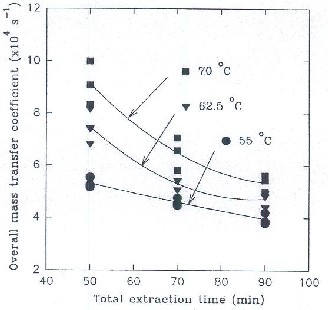
It was confirmed that the raw material used in this work, the backmixing in solid phase was of minor importance [2]. In
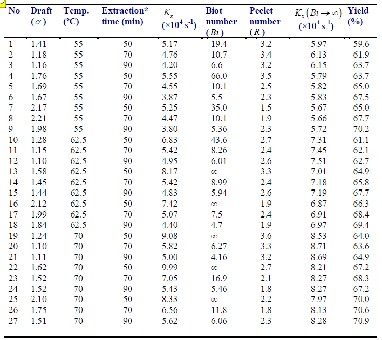
*Extraction times of 50, 70 and 90 min. were obtained by controlling screw speed at 3.76, 2.69 and 2.09 rpm, respectively.
IJSER © 2012
The research paper published by IJSER journal is about The Backmixing-Diffusion Concept for Mass Transport Phenomena of Pineapple Juice Extraction Using a Reversing Continuous Countercurrent Extractor 7
ISSN 2229-5518
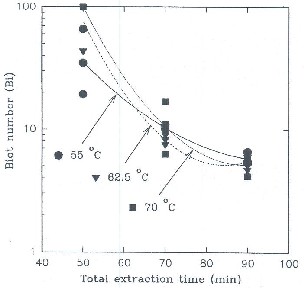
end (the lower end) backmixing was considerably higher than at the liquid entering end where the flow approached plug flow. Similarly, it can be deduced that Bi was higher at the lower end than at the other end due to better fluid movement.
The summary of extraction yield for all 27 RCCE trials are pre- sented in Fig. 8. In general, the higher the draft, temperature and extraction time, the higher was the yield. However, the increasing in the total extraction time too high (say > 90 min) was much less effective in obtaining greater yield.
It should be noted that the yields of all trials were not greater than 70 %. This can be clearly explained by consider- ing simulation results of the diffusion-backmixing model as
follows; Fig. 9 and 10 present the yield as related to Bi , R
and total extraction time at the temperature of 62.5 ºC as pre-
dicted by the diffusion-backmixing model. Although it seems that, in general, Bi exhibits stronger effect on the yield than
R , the fact that
Bi 4
for all extraction trials indicate its
tures.
All experimental data from 27 trials fitted well with the diffu-
sion-backmixing model and Fig. 7 shows a sample run for
comparison, the results was from trial number 1 (Table 1).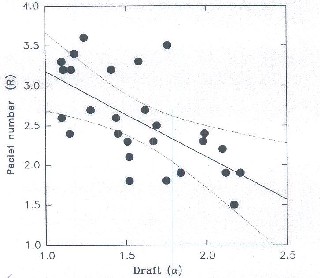
weaker effect. On the other hand, as we found that R has the
magnitude around 1.5-3.5, from Fig. 9 if we strict the total ex-
traction time not to exceed 90 min., we will never achieve a higher yield than 80 % even Bi is infinite. Thus it was the combined effect of finite Bi and high backmixing that limited the extraction yield to about 70 % for all extraction trials.
In Fig. 7, it can be seen that the model predicted the con- centration profile well in both solid and liquid phases. How- ever, the discrepancies were quite systematic. That is, the model predicted higher solute concentration in solid at near its entering end (the first 0-30 min.) but the predicted lower con- centration nearby the other end (the last 30-60 min). The oppo- site discrepancies were found in the liquid phase. This clearly
show that the assumptions of constant Bi and R along the
extractor were not strictly valid. In fact, near the solid entering
IJSER © 2012
The research paper published by IJSER journal is about The Backmixing-Diffusion Concept for Mass Transport Phenomena of Pineapple Juice Extraction Using a Reversing Continuous Countercurrent Extractor 8
ISSN 2229-5518
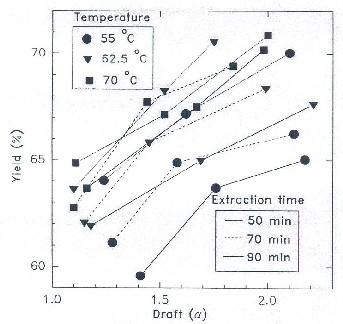
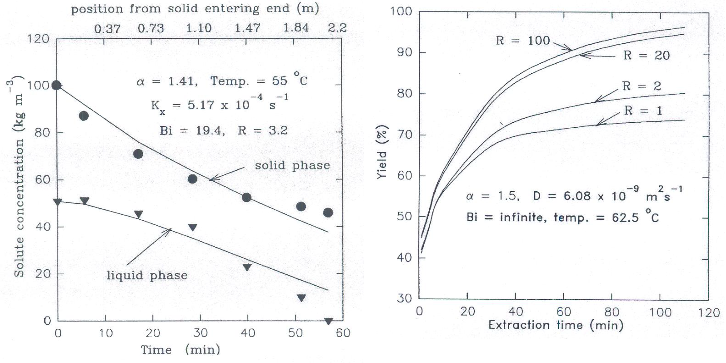
Fig 9. The effect of Peclet number ( R ) and total extraction time on yield of extraction.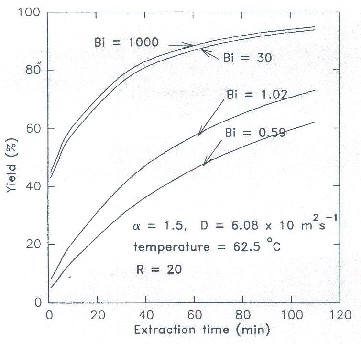
Fig. 10. The effect of Biot number ( Bi ) and total extraction time on yield of extraction.
IJSER © 2012
The research paper published by IJSER journal is about The Backmixing-Diffusion Concept for Mass Transport Phenomena of Pineapple Juice Extraction Using a Reversing Continuous Countercurrent Extractor 9
ISSN 2229-5518
The study of mass transfer in the pineapple juice extraction![]()
VL = Liquid volume of mass transfer
x = solute concentration in solid phase (kg/m3)
x = average solute concentration in solid phase (kg/m3)
using RCCE was critically conducted. The results indicated
that the efficiency of the system can be improved by reducing
axial dispersion while promoting local mixing. This may be
x* xin xout
= solute concentration in solid phase at equilibrium
= solute concentration in solid phase at inlet (kg/m3)
= solute concentration in solid phase at outlet (kg/m3)
achieved by increasing the length of the trough while keeping
the total extraction time constant. However, since there are
other factors which have not been investigated here such as
y = solute concentration in liquid phase (kg/m3)
y = solute concentration in liquid phase at equilibrium
the percent forward progression and the dimensions of raw
yin
yout
= solute concentration in liquid phase at inlet (kg/m3)
= solute concentration in liquid phase at outlet (kg/m3)
material, further study should be carried out before the im-
proving the design taking place.
The diffusion-backmixing model developed by Siripatana [6], Siripatana and Suparanon [18], and modified here in this work can be used to explain the experimental data satisfactori- ly. The model found corresponding to Rittirut et al.’s work for the case of steady state condition [12], [14]. Yet, it has advan- tage which should be noted : 1) it is simple, requiring only at hand calculation, 2) It can be used to design an extractor from
z = relative length or dimensionless volume
α = draft of extraction![]()
= infinite
[1] D. J. Casimir, ―Counter Current Extraction of Soluble Solids from
Foods,‖ CSIRO. Fd. Res. Quar., 53(2), 38-43, 1983.
[2] T. Thummadetsak, ―Mass Transfer in Pineapple Juice Extractor‖
Master of Engineering Thesis, Prince of Songkla University, Thail-
fundamental parameters such as requires only batch extraction trials.
a = characteristic length
![]()
A = area of mass transfer
D , ,
and t p . The design
and. (in Thai), 1997.
[3] National Food Institute (NFI) of Thailand, ―Thailand Food STAT -
Information Center‖ http://www.nfi.or.th/services-research.aspx, 2011.
[4] Bioquip. “The Application of Bioquip Countercurrent Extractor to the Commercial Production of Apple Juice by Continuous Diffusion Ex- traction,” Company Report. Bioquip Australia Ply Ltd., NSW, Austral- ia, 1984.
[5] S. Gunasekaran, R.J. Fisher, and D.J. Casimir, ―Predicting Soluble
![]()
Bi = Biot number of mass transfer
D = diffusivity from diffusion theory (m2/s)
Ds = solute diffusivity (m2/s); in-solid diffusivity (m2/s)
Solids Extraction from Fruits in a Reversing Single Screw Counter
Current Diffusion Extractor‖, J. Food.Sci., 5(54), 1261-1265, 1989.
[6] C. Siripatana, ―Mass Transfer in a Reversing Counter Current Extrac-
Dx = volumetric dispersion coefficient in solid phase (m6/s)
D y = Volumetric dispersion coefficient in liquid phase (m6/s)
tor‖, M.App.Sc. Thesis, The university of New South Wales, Aus- tralia, 1986.
K s = overall mass transfer coefficient (m/s)
[7] W. Rittrut, W., ―Mathematical Simulation of Solid-Liquid Diffusion
K x = volumetric overall mass transfer coefficient (1/s)
l = characteristic length (m) of each dimension of block (m)
in Continuous Countercurrent Extraction Process.‖ Ph.D Thesis,
Walailak University, Thailand, 2009.
![]()
L = volumetric flow rate of liquid phase (m3/s)
[8] Y.C. Lee and H.G. Schawartzberg, ―Effects of Axial Dispersion Dur-
L0 = Vol. flow rate of liquid phase at inlet of extractor (m3/s)
L f = Vol. flow rate of liquid phase at outlet of extractor (m3/s)
ing Solid-Liquid Extraction‖ Engineering and Food Vol. 1, W.E.L. Spiess, H. and Schubert, (ed.), Elsevier. London, 1990.
m = solute equilibrium distribution coefficient
P = Peclet number in solid phase
R = Peclet number in liquid phase
S = Vol. flow rate of liquid phase (m3/s)
[9] J.A.M. Spanink, ―Caluculation Method for Solid-Liquid Extractor‖ in Progress in Food Engineering, Cantarelli, C. & Peri, C. (ed.) Forster - Verlag AG/Forter, p. 109-125, 1983.
[10] J.C. Mecklenburgh and S. Hartland, The theory of backmix-
S0 = Vol. flow rate of liquid phase at inlet of extractor (m3/s)
ing, John Wiley & Sons, London, 1975.
S f = Vol. flow rate of liquid phase at outlet of extractor (m3/[1s1)] N. Suparanon, ―The Development of Mathematical Model and Co n-
Sh = Sherwood number
![]()
t = time (s)
trol Method for Juice Extraction Process‖ Master of Engineering
Thesis, Prince of Songkla University, Thailand. (in Thai), 1997
t f = theoretical extraction time as described by equation (4)[1(2s]) W. Rittirut, C. Thongurai and C. Siripatana, ―Mathematical Simu-
tl = time lead due to initial solute distribution in solid (s)
t p = time delay due to plasmolysis (s)
= shape factor =aA/V
= ratio of liquid to solid flow rate = L / S
lation of Solid-Liquid Diffusion in Continuous Countercurrent Ex- traction Process, Part I-Modeling Development,‖ IJCRE , vol. 8, Ar- ticle A112, 1-35, 2010.
[13] W. Rittirut and C. Siripatana, ―Diffusion Properties of Garcinia Fruit
![]()
vx = accumulated vol. of solid phase from its inlet point (m3)
vy = accumulated vol. of liquid phase from its inlet point (m3)
Acids (Garcinia atrovirridis),‖ Walailak J. Science & Tech., 4 (2), 187-
202, 2007.
Vx = total volume of solid phase at position considered
Vy = total volume of liquid phase at position considered
x = total volume of solid phase in extraction unit
y = total volume of liquid phase in extraction unit
[14] W. Rittirut, C. Thongurai and C. Siripatana, ―Mathematical Simu- lation of Solid-Liquid Diffusion in Continuous Countercurrent Ex- traction Process, Part II-Modeling Verification and its Application,‖
IJCRE , vol. 8, Article A113, 1-28, 2010.
V = volume of mass transfer
[15] C. Siripatana, ―Solute Diffusion in Fruit, Vegetable, and Cereal
IJSER © 2012
The research paper published by IJSER journal is about The Backmixing-Diffusion Concept for Mass Transport Phenomena of Pineapple Juice Extraction Using a Reversing Continuous Countercurrent Extractor 10
ISSN 2229-5518
Processing I: Simplified Solution for Diffusion in Anomalous
Shapes.‖ Songklanakarin J.Sci.Technol., 19(1), 78-88, 1997.
[16] C.J. Beristain, E. Asuara, R. Cortes, and H.S. Garcia, ―Mass Transfer
During Osmotic Dehydration of Pineapple Rings,‖ Int. J. of Food Sci.
& Technol., 25, 576-582, 1990.
[17] C. Sodchit, ―Mechanism of Chemical and Physical Changes of Os- motic Dehydrated Pineapple‖ Master of Science Thesis, Prince of Songkla University, Thailand. (in Thai), 1993.
[18] C. Siripatana and N. Suparanon, ―Solute Diffusion in Fruit, Vegeta-
ble, and Cereal Processing II: Simplified Solution of Continuous
Countercurrent Diffusion‖ Songklanakarin J.Sci.Technol., 19(1), 89-99,
1997.
IJSER © 2012